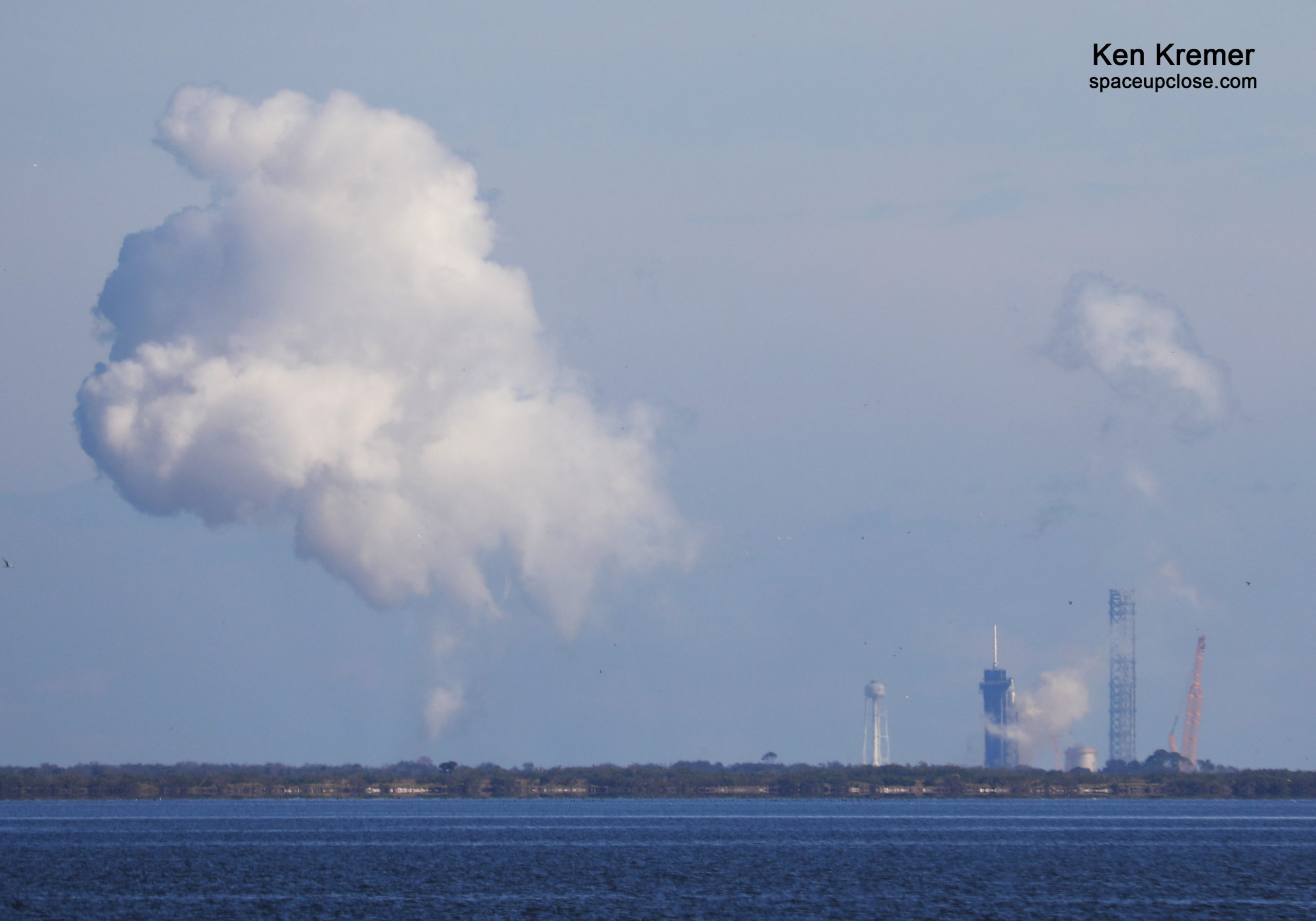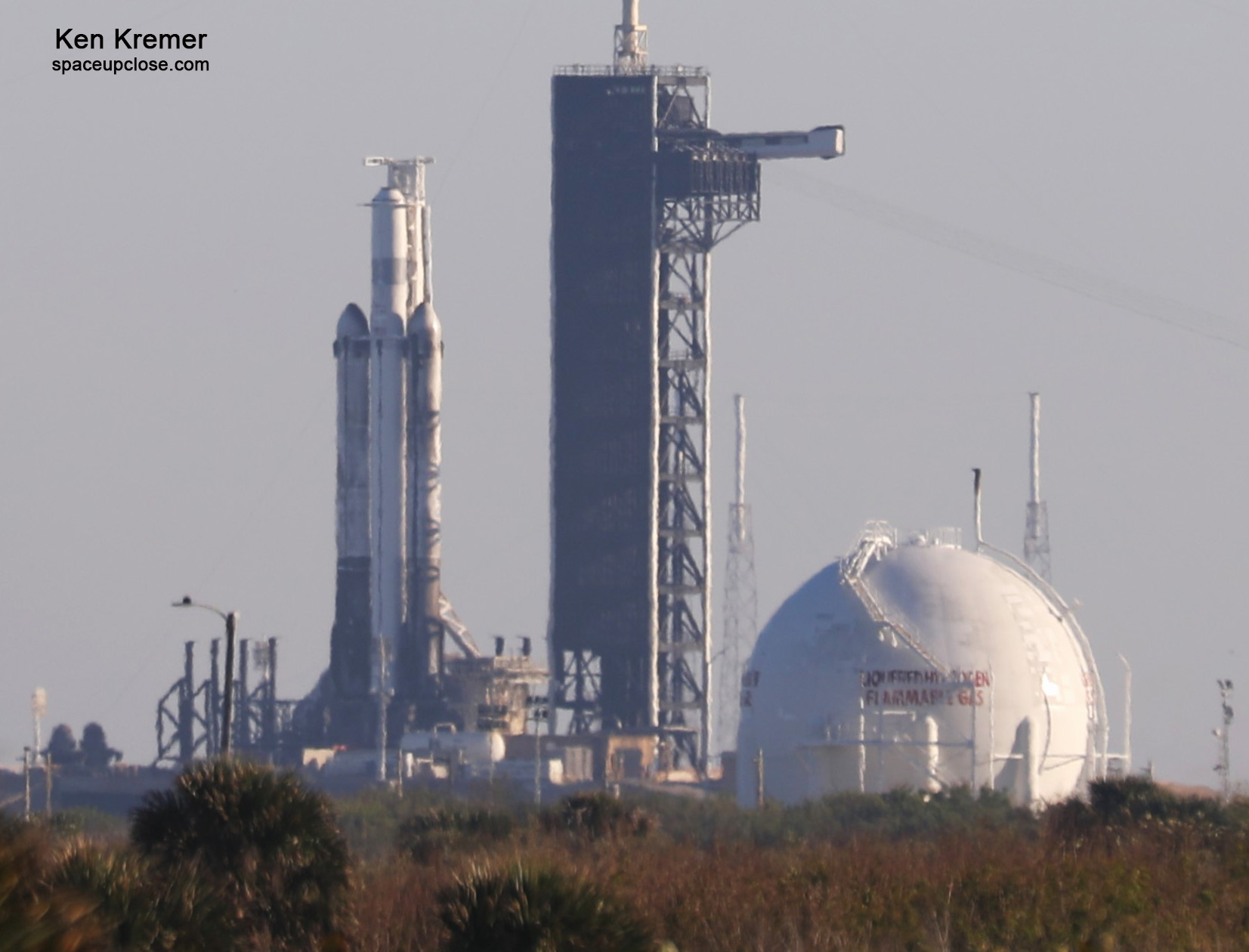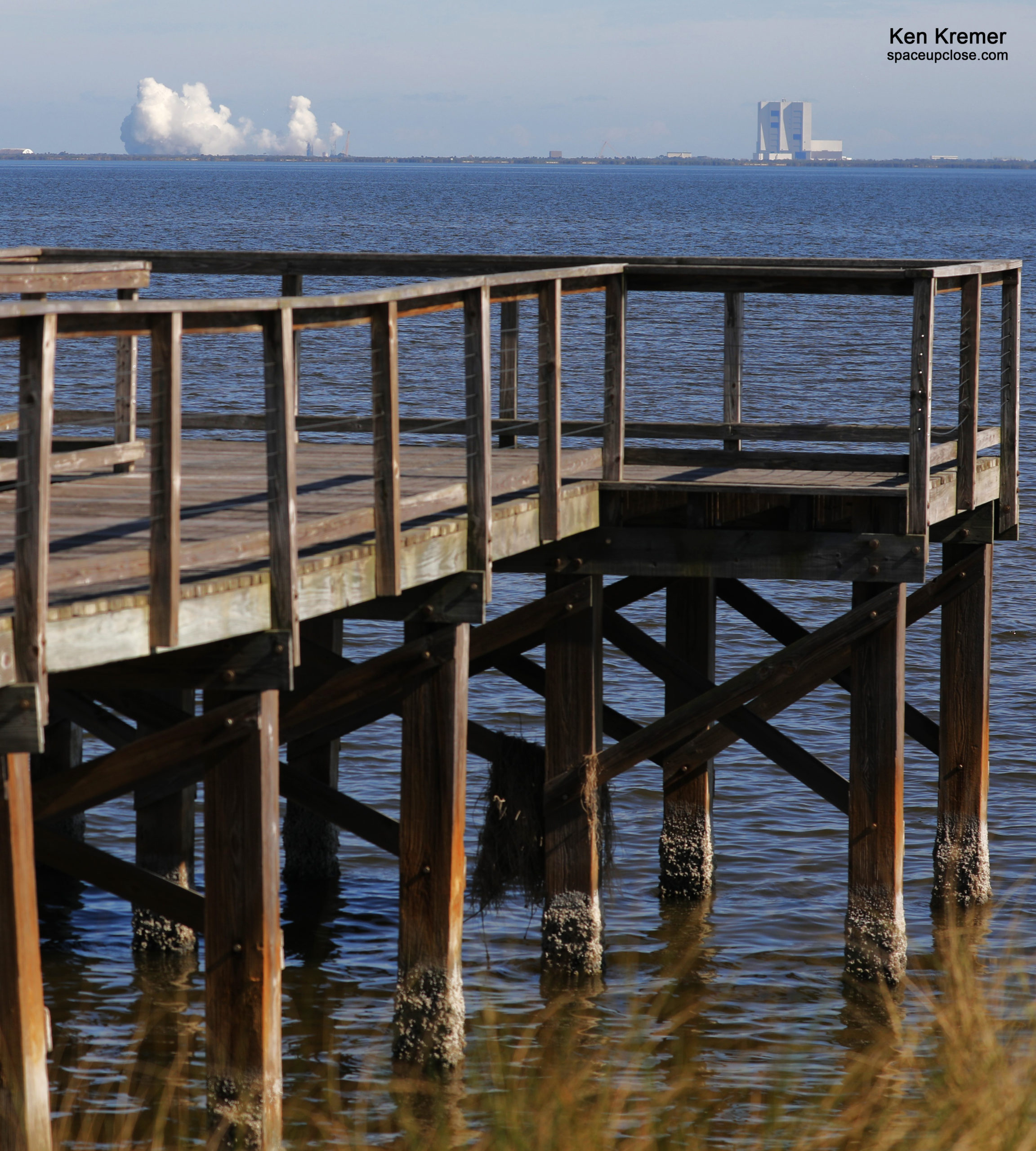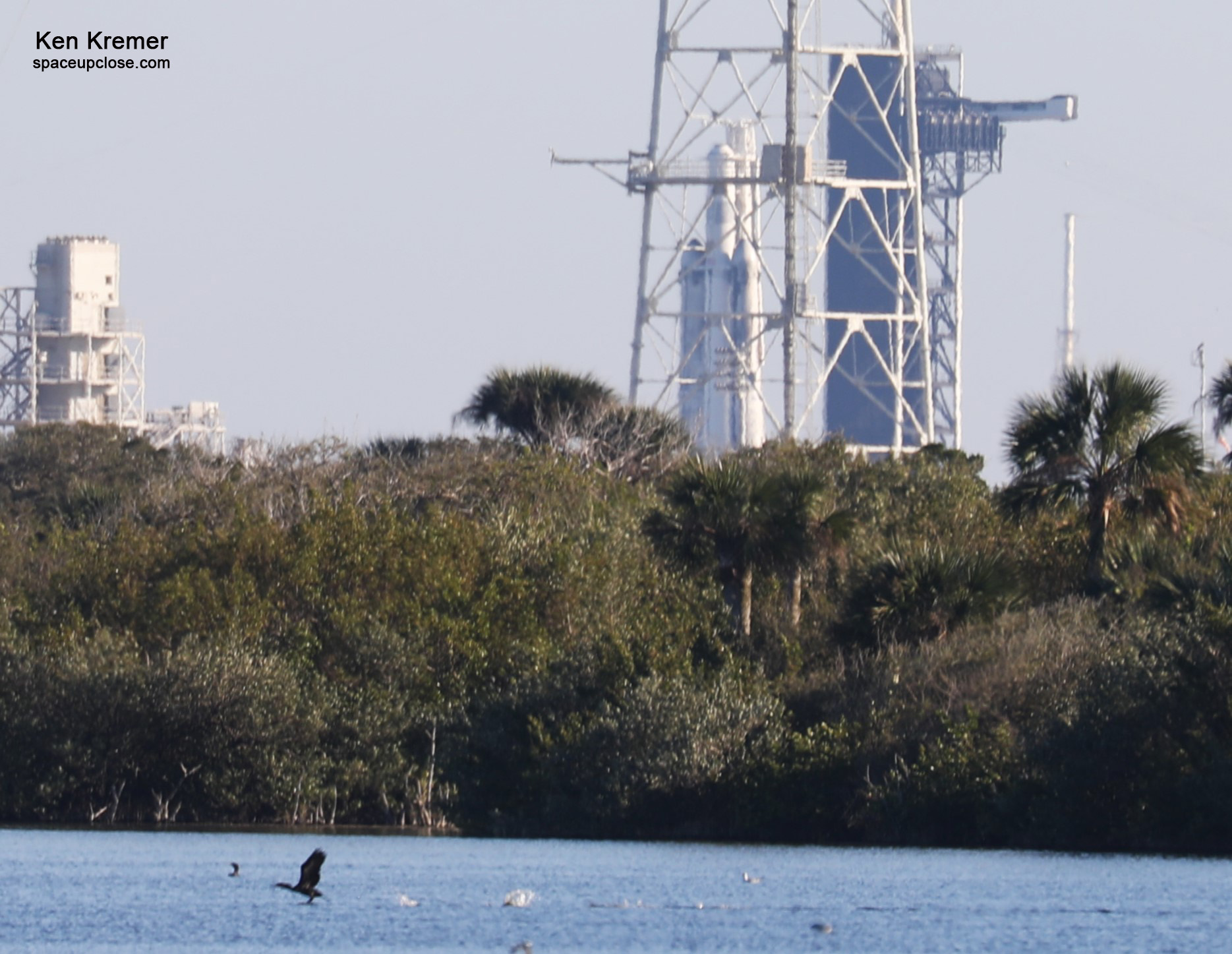
TITUSVILLE/PLAYALINDA BEACH, FL – SpaceX conducted a successful lunchtime static fire test of their triple stick Falcon Heavy rocket standing vertical and headless minus the nose cone on the launch pad, Tuesday, Jan 10, rumbling across the Space Coast and paving the path towards the first launch of the mammoth vehicle in 2023 from the Kennedy Space Center in Florida – on a national security military mission for the United States Space Force.
The mission designated USSF-67 for the United States Space Force is targeted for a dinnertime weekend liftoff no earlier than (NET) Sat. Jan 14 carrying a pair of critical military satellites in a stacked configuration encapsulated in the nose cone to geosynchronous orbit (GEO).

USSF-67 is “comprised of two co-manifested satellites used to transmit military communications data and transport payloads to space,” says the Space Force.
After SpaceX engineers fueled the Falcon Heavy with RP-1 and liquid oxygen propellants they ignited all 27 first stage Merlin 1D engines on all three Falcon 9 cores at 12:45 PM EDT Tuesday (1745 GMT) – thereby generating 5.1 million pounds of thrust while hold down clamps kept the triple core rocket firmly on top of the pad at Launch Complex 39A on NASA’s Kennedy Space Center.

The brief but full duration test fire lasted several seconds and sent a massive exhaust vapor cloud spewing from the base of the rocket and out through the flame trench and upwards swirling and whipping in the winds.

The Falcon Heavy was tested in the ‘headless’ configuration of the first and second stages – meaning there was no nose cone or payload on top to keep the multi-billion dollar collection of U.S. Space Force satellites codenamed USSF-67 safe in case something went awry during the engine firing.

The Space Force’s upcoming USSF-67 launch of multiple satellites into a geosynchronous orbit and some 22,000 miles above the equator marks the second national security mission on a Falcon Heavy and is certain to be critically important for U.S. national defense.

The hold down static fire test lasted nearly 10 seconds and generated a huge exhaust plume that was visible plus a very load window shaking roar audible from our vantage point about a dozen miles distant in Titusville along the Indian River Lagoon.

SpaceX confirmed a successful engine test firing via tweet about an hour later and announced they are targeting NET Saturday, Jan. 14 for liftoff of the USSF-67 national security mission at 5:55 p.m. EDT (2255 GMT) from pad 39A.
Full duration static fire of Falcon Heavy complete; targeting no earlier than Saturday, January 14 for launch of the USSF-67 mission from Florida pic.twitter.com/EJdditiphe
— SpaceX (@SpaceX) January 10, 2023
The launch window runs just over a half hour until 6:33 p.m. ET (2333 GMT) on Jan. 14
A backup launch opportunity is available on Sunday, Jan. 15 at 5:56 p.m. ET (2256 GMT), using SpaceX’s Falcon Heavy rocket.
Following stage separation, Falcon Heavy’s two first stage side boosters will return to Earth and land on LZ-1 and LZ-2 back at Cape Canaveral and the Space Coast – for near simultaneous and very exciting touchdowns at LZ-1 & LZ-2 some eight minutes after liftoff – sending screaming sonic booms across the region.

Enjoy our static test fire photos of the headless SpaceX Falcon Heavy on the USSF-67 mission and photos from Playalinda Beach taken for Space UpClose by Ken Kremer and Jean Wright.
The Falcon Heavy is currently the second most powerful operational rocket in the world – having been recently eclipsed by NASA’s Artemis Moon rocket
It was launched only 4 times previously since its debut test flight mission in 2018 with a Tesla Roadster car from SpaceX CEO Elon Musk.
The USSF-67 mission for the United States Space Force counts as the fifth Falcon Heavy mission.
The prior mission was launched on 1 Nov. 2022 – also a classified mission for the U.S. Space Force
Up to 5 Falcon Heavy missions will be launched in 2023
Multiple satellites will be carried to orbit by the Falcon Heavy featuring 1 new booster cores and two recycled side cores
The center core will be expended since the Space Force needs to use all the thrust available from the rocket.
The Falcon Heavy is comprised of three Falcon 9 boosters lashed together.
The side cores are recycled from the USSF mission when they also landed back at the Cape LZ-1 and LZ-2 and will save significantly on launch costs.
“The efficiencies garnered from reusability benefit all customers, adding flexibility to a dynamic launch queue and cost savings,” said the Space Force.
Payload details from the Space Force:
The forward spacecraft, SSC’s Continuous Broadcast Augmenting SATCOM (CBAS)-2, is a satellite destined for geosynchronous orbit to provide communications relay capabilities in support of our senior leaders and combatant commanders. The mission of CBAS-2 is to augment existing military satellite communication capabilities and continuously broadcast military data through space-based satellite relay links.
The second spacecraft, the Long Duration Propulsive ESPA (LDPE)-3A, is used to rapidly place multiple, diverse payloads into orbit and provide critical data to inform and influence future U.S. Space Force programs. This LDPE-3A mission includes two SSC payloads: catcher and WASSAT, and three payloads developed by the Space Rapid Capabilities Office (SRCO). The SRCO payloads include two operational prototypes for enhanced situational awareness, and an operational prototype crypto/interface encryption payload providing secure space-to-ground communications capability. The LDPE spacecraft will continue to provide access to space for multiple DoD space Science & Technology (S&T) demonstration experiments.
“This is a complex mission and truly represents what Assured Access to Space is about and is why we’re so enthusiastic about this upcoming launch…our second Falcon Heavy in just months,” said Maj. Gen. Stephen Purdy, program executive officer for Assured Access to Space, in a statement.
“The teamwork I’ve seen preparing for this launch has just been exceptional. We’ve worked side-by-side with SpaceX to ensure all boxes are checked…that all systems are GO. And our processes for getting to that ‘go’ decision at LRR are thorough and constantly evolve, so they’re also more efficient than ever.”

The Falcon Heavy has recently been exceeded in thrust by NASA’s SLS and soon by SpaceX’s Starship heavy lifters
The rocket will now be lowered horizontal and rolled back into the processing hangar at pad 39A where the nose cone holding the Space Force payloads will be attached and integrated with the rest of the Falcon Heavy rocket.
Thereafter the full Falcon Heavy stack will be rolled back out to pad 39A and be raised vertical for liftoff on Jan. 14.
The fully integrated Falcon Heavy stands 229 feet (70 meters) tall and 40 feet (12.2 meters) wide.

Watch Ken’s commentary about Project Artemis, SpaceX Falcon Heavy, Crew-5, NASA SLS cryo and WDR tests, NASA SpaceX Crew & Cargo Dragons and more
Jan 3/4: WFTV ABC News Orlando interview about todays Jan 3 SpaceX Transporter 6 launch – 1st of 2023 – and record setting year ahead with many exciting missions for NASA and private astronauts, science probes, mission, US Space Force, new rockets like ULA Vulcan & more!

Dec 28/29: Fox 35 Orlando – Watch my commentary about NASA’s fantastic success in space exploration in 2022 and ambitious schedule of whats ahead in 2023:
https://www.fox35orlando.com/video/1159922
Dec 11/12: BBC World News TV interview about successful splashdown of NASA Orion concluding the 25 day Artemis 1 lunar test flight around the Moon and back, and how that sets up a human return to the Moon on Artemis 2 and landing on Artemis 3. Plus what’s beyond for NASA deep space exploration to Mars and the search for life beyond Earth

Watch Ken’s continuing reports about Artemis, SpaceX missions, SLS, Orion and NASA missions, SpaceX Crew and Cargo Dragons, SpaceX Axiom, JWST, DART, Lucy Asteroid mission, GOES, SpaceX Starlink, Commercial Crew and Starliner and Crew Dragon, Blue Origin and Space Tourism, and onsite for live reporting of upcoming and recent SpaceX and ULA launches including Crew 1 & 2 & 3 & 4 & 5, ISS, Solar Orbiter, Mars 2020 Perseverance and Curiosity rovers, NRO spysats and national security missions and more at the Kennedy Space Center and Cape Canaveral Space Force Station.
Stay tuned here for Ken’s continuing Earth and Planetary science and human spaceflight news: www.spaceupclose.com – twitter @ken_kremer – email: ken at kenkremer.com
Dr. Kremer is a research scientist and journalist based in the KSC area, active in outreach and interviewed regularly on TV and radio about space topics.
………….
Ken’s photos are for sale and he is available for lectures and outreach events
Please consider supporting Ken’s work by purchasing his photos and/or donating at Patreon
https://www.patreon.com/kenkremer
Upcoming and recent space events and talks by Ken Kremer & Jean Wright
Jan 12, 2023: 10 AM at Westminster Retirement Center in Orlando/Winter Park, Florida: Presentation by Jean Wright – “Sew Sister to the Stars- How the Humble Art of Sewing Transformed the World of Flight”+ Artemis 1 Moon rocket update

Nov 29 at UCF, Orlando Florida: Presentation by Jean Wright – “Sew Sister to the Stars- How the Humble Art of Sewing Transformed the World of Flight”
Upcoming and recent space events and talks by Ken Kremer & Jean Wright
Jan 7/11/13, 2023; Dec 7/10/15 and Nov 25/29 from 7 to 9 PM Quality Inn, Titusville, FL: Join Ken and Jean for Artemis 1, Falcon Heavy and space mission and rocket launch outreach. Ask us anything. plus display our photos and space apparel items for sale



